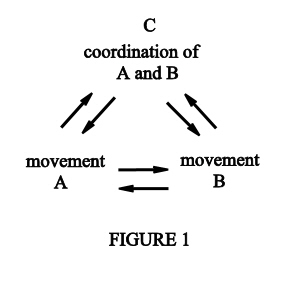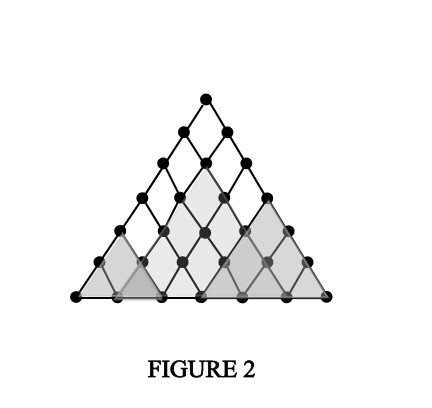

ACTION
CONCEPTS
(August, 2005)
There may be initial difficulties with this subject since the action concept as defined here is not recognised (also this information should be taken in conjunction with the other articles on skills, such as The Mechanics of Coordination). We understand the word 'concept'; for example, a single idea is a single concept but how does this apply to physical action?
If we imagine a simple movement of, say, the hand, from A to B, a short distance, then since this is a learned movement for a normal person, there is a single action concept for this motion. The individual thinks the idea of the whole movement, in fact, essentially thinks of the end result. A mental image of the position of the hand at B is created.
Note that this mental image at B may contain a visual picture of the hand at B but more important it contains a kinaesthetic perception of the feeling of the hand at B. Remember that the kinaesthetic sense gives the perception of position and movement.
The kinaesthetic sense reveals the programmes for the movements. It is the interface between the input consciousness (and 'attention' energy) and the programme and memory of physical movements. Thus the action concept, which begins with the original ideation, then manifests within the kinaesthetic sense with or without an accompanying visual image. A single action concept is sufficient to control this movement (from A to B). But what if the movement of interest is not learned?
During the learning process we must focus on the parts and not the whole. The parts must be joined or coordinated. One automatically uses the largest parts that are learned and connects these together. It takes a certain amount of effort and concentration, in other words, deliberation, to link together movements (that are not already learned). The mind must envelop two separated motions as one whole. By repeating this, a third state (another action concept) forms which is recorded within the learning pattern, which spans the first two.
Figure 1 shows the coordination of movements A and B by means of C, which is recorded in a separate layer. Technically this is slightly higher dimensional. It will have a higher frequency. Thus now, with this configuration, A and B can operate independently at the lower level, or together, at the higher level. Note that this configuration is basic to all the previous figures, showing the learning pattern structure. In fact, and to digress a little, the triangle CAB will be the basic computer element for life's creations but C will have split into A and B, a polarity, and C will monitor the integration between A and B. This would be the equivalent of two fractal dimensional levels 1) A and B, and 2) C. If C is severed from A and B, chaos and negativity (ego, etc.) can set in at the level of A and B.


Now Figure 2 shows a larger learning pattern diagram. Observe the 'pyramids' within the overall one. All the dots or bits can be connected to form a complete gradient of pyramids, as is the case when a combination of movements is thoroughly learned. They can all be operated independently, ranging from a tiny motion (small pyramids) to a larger one (greater pyramid).
All these pyramids represent action concepts. The mind or input consciousness ideated the action concept in the first place--with some effort. This was gradually recorded, through repetition, within the learning pattern. The learning pattern then feeds back this imprint or template to the input consciousness and literally moulds it. The learning pattern template draws from the input energy (vaguely directs it) and amplifies and distributes this energy to create the correct movements. It aids the action concept.
For a learned movement then, or learned movements, every possible (in theory) action concept is inherent within the learning pattern. This enables the input to control any state of the coordinated motions. This is the key to being able to access the system instantaneously (instant computer access by consciousness). For example, if one is executing a continuous sequence of skilled movements, such as in playing a music keyboard, if these movements have been learned well, one can take one's attention off the actions but return this attention (input consciousness), and smoothly merge into the inherent action concepts of the learning pattern to control or change any part.
Thus the action concept is the initial idea, the function, but then it creates, by repetition, its own structure by means of the learning pattern. The learning pattern feeds back the pattern, the action concept has given it, facilitating the formation of the action concept. Thus the action concept is configured and formatted accurately.
When a person is performing a skill the attention is contiguously moving from one action concept to another, keeping the activity going. This is achieved by resonance. The frequencies of the input function are compatible and matched within the learning- pattern structure. A perfect interface has been created which actually causes the individual to 'dramatise' being the learning pattern indistinguishably from self or consciousness. The person thinks he or she is controlling consciously the individual movements, but in fact at any reasonable speed, the attention is focussed on the larger action concepts. These larger action concepts regulate the programming of the smaller action concepts automatically. Note that these levels or strata (going up the pyramid) are nested, that is, within one another. This is inner space--it doesn't go 'up' but within. [This is the same inner space used by spacecrafts, and it is also the same 'within' that Jesus reiterated many times in a spiritual context. Note that spirituality could be defined as the multidimensional physics of inner space.]
Each action concept of different size has a different frequency but when the learning pattern is complete, that is, the movements have been learned, all the frequencies are in resonance--are in mathematical proportion. This means the learning pattern acts as one whole. Figure 1, remember, illustrates either an element of a larger learning pattern or can be regarded as the smallest unit which may regulate the action concept for a fraction of a movement (small part).
This interrelationship between the parts is not only holistic but is holographic, since the frequencies are in resonance. Any one action concept activates the whole group. Also the power of the total information of the group (whole learning pattern) can be focussed into any part. This means any tiny movement is reinforced by all the other action concepts (movements). This is a perfect system. This is holographic amplification.
Holistic systems, which science ignores, are difficult to understand since any one resonant part changes every other part and the whole. The energy is hugely amplified by this. The holistic interconnectedness between the parts, sub-parts and whole is not only in space but also in time. There is a holographic span in time of a degree governed by the development of the skill. During the execution of the movements of a learned skill the kinaesthetic sense of the physical action in the moment manifests not only the information, or sense of the present position or motion, but also simultaneously the future positions within the holographic span. Every element within this span--even future ones--aids the present one being executed.
There may be difficulty in believing that all the action concepts, small to large, in a holographic (learned) learning pattern are superimposed hierarchically and experienced simultaneously. Clearly the conscious mind cannot observe this; it can only observe one state at a time. This experience is mainly unconscious but vaguely perceptible within the margin of consciousness.
Although an action concept can be ideated without physical movement, that is, it can be felt within the kinaesthetic sense in actual physical movements in skills, the action concept creates a tension state in the muscles corresponding to the span of this action concept. When a sequence of movements is being learned, small action concepts will be used giving deliberate selections of tensions. At the other extreme of complete learning (the holographic continuum), one whole action concept is sufficient to perpetuate continuous motion and this is felt as a general stiffness (less with greater skill) in the muscle group involved. No selection of individual tensions by means of individual action concepts is necessary. The larger (whole) action concept requires no more effort or thinking than a small action concept.
Thus the voluntary control over the tension is governed by the action concept. For a learned sequence one automatically operates the widest action concept as though voluntarily creating one tension effect for this whole movement. If the QCS wasn't developed (movements not learned), all detail of the motion in, say, going from A to B, via up/down, left/right, or whatever, would seize up or fuse out if one tried to apply the whole (learned) action concept.
As a final summary, the input consciousness initially acts as cause, which creates its effect within the learning pattern by building up structures. These structures are like moulds/templates and now format the input consciousness and the action concepts. The input is now more refined and acts as cause again over the structure, which improves and feeds back its format to the input; and on and on, continuously refining the programme, enabling energy to be distributed accurately to provide the desired movements.